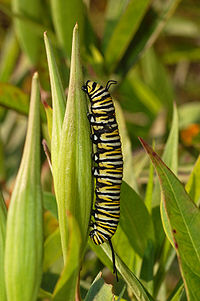
Photo from wikipedia
Nanosilicon applications have been shown to increase plant defenses against both abiotic and biotic stresses. Silicon quantum nanodots (Si NDs), a form of nanosilicon, possess excellent biological and physiochemical properties… Click to show full abstract
Nanosilicon applications have been shown to increase plant defenses against both abiotic and biotic stresses. Silicon quantum nanodots (Si NDs), a form of nanosilicon, possess excellent biological and physiochemical properties (e.g., minimal size, high water solubility, stability, and biocompatibility), potentially making them more efficient in regulating plant responses to stress than other forms of silicon. However, to date, we still lack mechanistic evidence for how soil-applied Si NDs alter the regulation of plant physical and chemical defenses against insect herbivores. To address this gap, we compared the effect of fluorescent amine-functionalized Si NDs (5 nm) and the conventional fertilizer sodium silicate on maize (Zea mays L.) physical and chemical defenses against the oriental armyworm (Mythimna separata, Walker) caterpillars. We found that 50 mg/kg Si NDs and sodium silicate additions inhibited the growth of caterpillars the most (35.7% and 22.8%, respectively) as compared to other application doses (0, 10, and 150 mg/kg). Both Si NDs and silicate addition activated biosynthesis genes responsible for chemical (benzoxazinoids) and physical (lignin) defense production. Moreover, Si NDs upregulated the gene expression of antioxidant enzymes (SOD, CAT, and POD) and promoted the antioxidant metabolism (flavonoids) in maize leaves under M. separata attack. Finally, we show that, under field conditions, Si ND addition increased maize cob weight (28.7%), cob grain weight (40.8%), and 100-grain weight (26.5%) as compared to the control, and more so than the conventional silicon fertilizer. Altogether, our findings highlight the potential for Si NDs to be used as an effective and ecofriendly crop protection strategy in agroecosystems.
Journal Title: ACS nano
Year Published: 2023
Link to full text (if available)
Share on Social Media: Sign Up to like & get
recommendations!